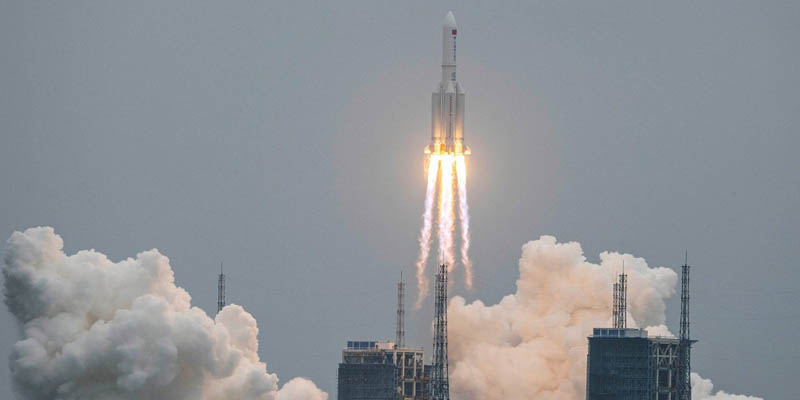- World
- Apr 30
China launches key module of new space station
• China’s ambitious space programme got a major boost on April 29 when it successfully launched the core module of its space station as part of its aim to complete the construction of the facility by the end of next year.
• The Long March-5B Y2 rocket, carrying the Tianhe module, blasted off from the Wenchang Spacecraft Launch Site on the coast of the southern island province of Hainan.
• The unmanned module will become living quarters for three crew members on a permanent space station that it plans to complete by the end of 2022.
• Tianhe, meaning Harmony of the Heavens, is one of three main components of what would be China’s first self-developed space station, rivalling the only other station in service — the International Space Station (ISS).
China’s space station programme
• Work on the space station programme began a decade ago with the launch of a space lab Tiangong-1 in 2011, and later, Tiangong-2 in 2016.
• Both helped China test the programme’s space rendezvous and docking capabilities.
• China aims to become a major space power by 2030. By 2045, it hopes to establish a programme operating thousands of space flights a year and carrying tens of thousands of tonnes of cargo and passengers.
• It has ramped up its space programme with visits to the Moon, the launch of an uncrewed probe to Mars and the construction of its own space station.
• The Tianhe launch was the first of 11 missions needed to complete the space station, which will orbit Earth at an altitude of 340 to 450 km.
• Tianhe has a total length of 16.6 meters, a maximum diameter of 4.2 meters and a take-off mass of 22.5 tonnes, and is the largest spacecraft developed by China.
• In the later missions, China will launch the two other core modules, four manned spacecraft and four cargo spacecraft.
• China will also send the Tianzhou-2 cargo spacecraft and Shenzhou-12 manned craft this year to dock with the core module. Three astronauts will be aboard Shenzhou-12 and stay in orbit for three months.
• Tianzhou-3 cargo craft and Shenzhou-13 manned spaceship will also be launched later this year to dock with Tianhe, and another three astronauts will then begin their six-month stay in orbit.
• The station will operate in low-Earth orbit at an altitude from 340 km to 450 km. It has a designed lifespan of 10 years, but experts believe it could last more than 15 years with appropriate maintenance and repairs.
• China aims to build Tiangong into a state-level space lab supporting the long stay of astronauts and large-scale scientific, technological and application experiments.
• The station is also expected to contribute to the peaceful development and utilisation of space resources through international cooperation, as well as to enrich technologies and experience for China’s future explorations into deeper space.
International Space Station
• A partnership between European countries (represented by European Space Agency), the United States (NASA), Japan (JAXA), Canada (CSA) and Russia (Roscosmos), the International Space Station is the world’s largest international cooperative programme in science and technology.
• The International Space Station weighs almost 400 tonnes and covers an area as big as a football pitch.
• It would have been impossible to build the Space Station on Earth and then launch it into space in one go. There is no rocket big enough or powerful enough. To get round this problem the ISS was taken into space piece-by-piece and gradually built in orbit, approximately 400 km above the Earth’s surface. This assembly required more than 40 missions.
• The first piece of the ISS was launched in 1998. A Russian rocket launched that piece. After that, more pieces were added. Two years later, the station was ready for people.
• The first crew arrived on November 2, 2000. People have lived on the space station ever since.
• Over time, more pieces have been added. NASA and its partners around the world finished the space station in 2011.
• The ISS circles the Earth taking 90-93 minutes. The exact number of orbits per day is usually less than 16 (generally 15.5 to 15.9 orbits/day).
• The ISS is the ninth space station to be inhabited by crews, following the Soviet and later Russian Salyut, Almaz, and Mir stations as well as Skylab from the US.
Manorama Yearbook app is now available on Google Play Store and iOS App Store


